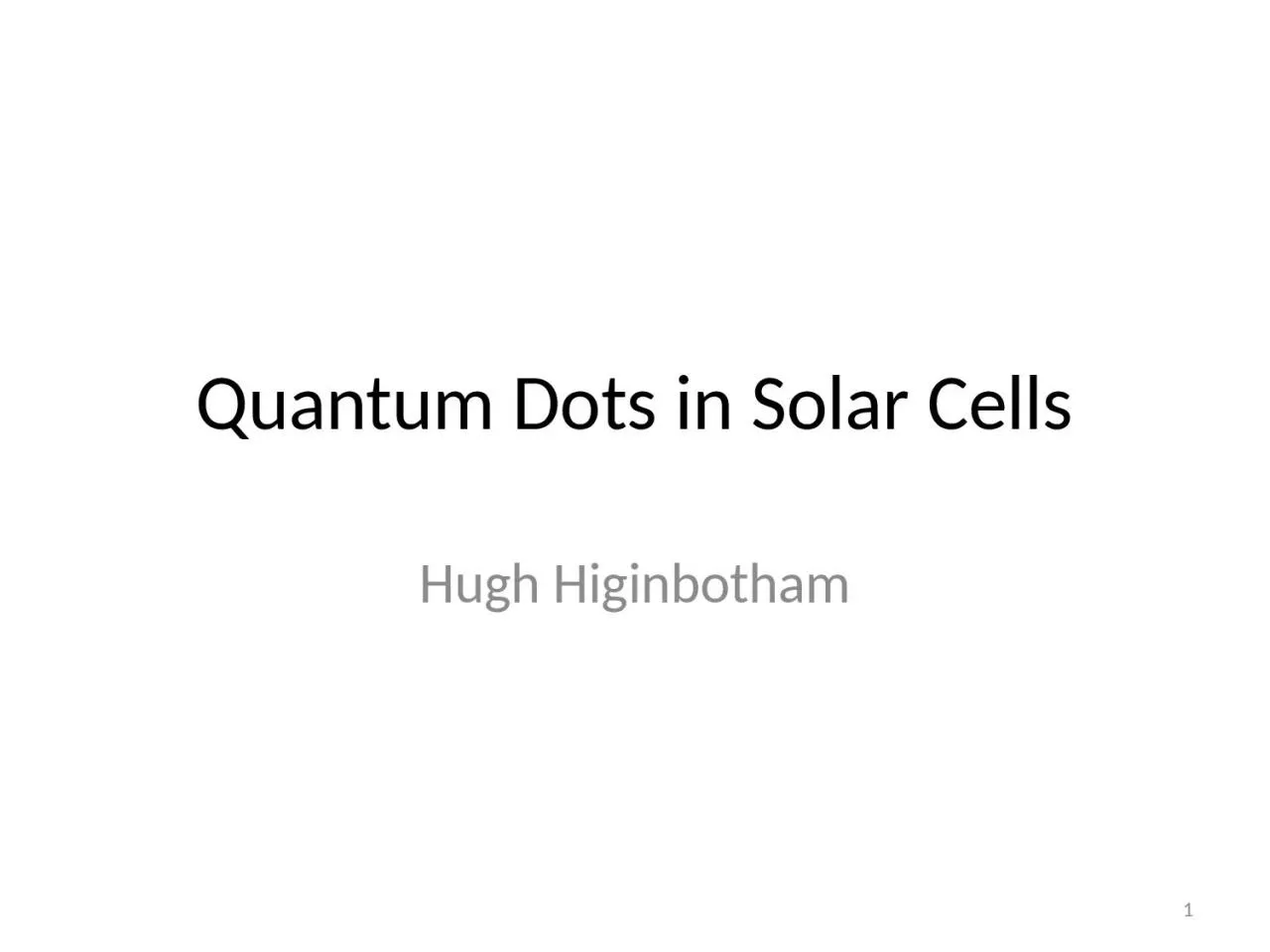

Hugh Higinbotham 1 Photovoltaics PVs Convert light to electric current GHG neutral energy source Currently cheaper than coalnatural gas on the utility scale but not efficient enough to be do well in current energy market ID: 1045849
Download Presentation The PPT/PDF document "Quantum Dots in Solar Cells" is the property of its rightful owner. Permission is granted to download and print the materials on this web site for personal, non-commercial use only, and to display it on your personal computer provided you do not modify the materials and that you retain all copyright notices contained in the materials. By downloading content from our website, you accept the terms of this agreement.
1. Quantum Dots in Solar CellsHugh Higinbotham1
2. Photovoltaics (PVs)Convert light to electric currentGHG neutral energy sourceCurrently cheaper than coal/natural gas on the utility scale, but not efficient enough to be do well in current energy marketHuge demand for more efficient and/or easier to manufacture technologies2
3. Semiconductor Review3https://commons.wikimedia.org/wiki/File:Semiconductor_band_structure_(lots_of_bands_2).svg(Uhl 2016)ni
4. Semiconductors in PVhttps://en.wikipedia.org/wiki/P%E2%80%93n_junctionJunction (e.g. p-n) creates potential gradient causing current to flow after photon absorption4(Uhl 2016)
5. Energy LossesResistiveReflectionTransmission, absorptionThermalizationRecombination5Schulze et al., Energy Environ. Sci.,2015, 8,103
6. Thin Film PVs6Todorov et al., Prog. Photovolt. (2013) 21, 82-87
7. Quantum DotsEngineering Bandgaps to create different potentials (e.g. finite square well)Surround low bandgap nanocrystal with higher -> “artificial atom” Discrete energy levels, closer spaced for larger dot(Riel 2008)
8. QDPV TypesMetal-Semiconductor (Schottkey) JunctionPolymer-SemiconductorSemiconductor-Semiconductor QDSSC8(Kamat 2008)
9. ExperimentsExperimental work in classifying QD mixes and their properties in actual PVs9(Kamat 2008)(Riel 2008)
10. Schottkey-Junction Cells10(Kamat 2008)Band bending only occurs in large metal-semiconductor junctionsGet improved energetics in nanoparticles with Fermi-level equilibration
11. Polymer-SemiconductorCreate junction between QD and organic polymerLower efficiencies, but potentially much cheaper to mass producePotential uses in medical devicesUse of 11(Huynh 2002)
12. Nanorod Detail(Kamat 2008)100nm100nm
13. QDSSCCoupling QDs to larger semiconductor particles to improve charge transfer efficiencyTiO2 has a larger bandgap, lower recombination rateCdSe can absorb wider range of frequencies13(Kamat 2008)
14. CdSe – TiO2 AbsorbanceExample absorption spectra of CdSe QDs coupled to TiO2 semiconductor particlesSize dependence is maintained even in composite systemsCan match absorption to solar spectrum14(Kamat 2008)
15. Size Effect on EfficiencyICPE = Incident Photon to Charge-carrier-generation EfficiencyUnknown why it’s higher for smaller dotsOne cool theory: hot electrons injectedMight reduce thermalization losses15(Kamat 2008)
16. Current State of QD-PVsMaximum efficiency: 10.6%Compare to 34% single junction max, 45% multi-junctionSuccessful IR sensitive QD-PVEfficiency above 4%Initial promise and huge sample space -> high research potentialPV companies face economic and geopolitcal hurdles, high risk/reward marketHelped with better PV technology16
17. ReferencesUhl, A., “A Solar Cell From a Material Science Perspective”, Univ. of Washington, HONORS 396 A.Charles Kittel (1995) Introduction to Solid State Physics, 7th ed. Wiley, ISBN 0-471-11181-3.https://en.wikipedia.org/wiki/Valence_and_conduction_bands (for image)Schulze et al., Energy Environ. Sci.,2015, 8,103 (for image)K. W. Johnston, A. G. Pattantyus-Abraham, J. P. Clifford, S. H. Myrskog, D. D. MacNeil, L. Levina, and E. H. Sargent, "Schottky-quantum dot photovoltaics for efficient infrared power conversion," Applied Physics Letters, vol. 92, p. 151115, 2008.J. P. Clifford, K. W. Johnston, L. Levina, E. H. Sargent , “Schottky barriers to colloidal quantum dot films,” Applied Physics Letters, vol. 91, pp. 253117, 2007.Kamat, Prashant V. "Quantum Dot Solar Cells. Semiconductor Nanocrystals as Light Harvesters †." J. Phys. Chem. C The Journal of Physical Chemistry C 112.48 (2008): 18737-8753. Web. 8 Oct. 2016. Riel, B. J. "An Introduction to Self-assembled Quantum Dots." American Journal of Physics 76.8 (2008): 750. Web. 8 Oct. 2016. Guyot-Sionnest, Philippe. "Colloidal Quantum Dots." Comptes Rendus Physique 9.8 (2008): 777-87. Web. Huynh, W.U. “Hybrid Nanorod-Polymer Solar Cells.” Science 295.5564 (2002) 2425-427. Web. 14 Nov. 201617